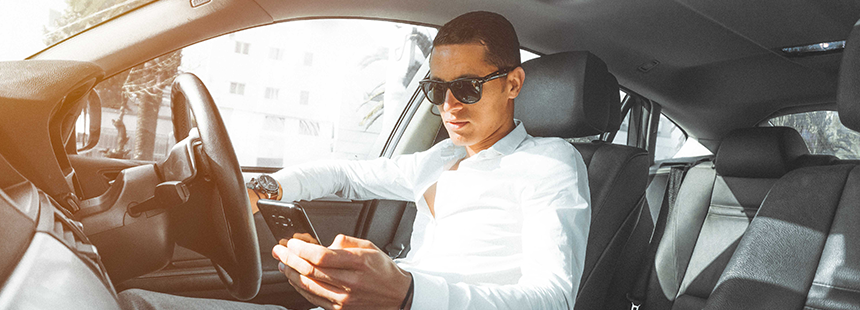Preventing and Stopping Distracted Drivers
Time and time again most of us are driving from place 'A' to place 'B' and notice something peculiar in the vehicle next to us.
Whether it be a driver gazing down to read a text message, trying to take a bite out of a meal, or simply dozing off to sleep, distracted drivers are a danger to all road users.
It's only a matter of time that a distracted driver, on the clock, will leave an employer with significant legal and financial implications to deal with due inpart to their careless behaviour.
Most of us in our driving lifetime will admit we have had close calls in relation to a motor vehicle incident.
In alarming statistics, accidents caused by inattention are associated with at least 11% of crashes on our roads. and 45% of drivers admit to being distracted whilst driving.
There is a high likelihood that some of these crashes and distracted drivers were at work when these incidents occurred, leaving the onus on an employer to deal with.

What Defines a Distracted Driver?
Any action within the vehicle that takes the driver's attention from the road will suffice.
These include actions such as using your phone, drinking or eating, smoking a cigarette, changing the radio, or engaging with a passenger.
The DPTI outline the 4 types of distraction on our roads.
Visual (things you see), Auditory (things you hear), Physical (things you do with your hands) and Cognitive (things you think about).
Every crash has its own unique circumstances; however, we are always quick to assume that a mobile phone is the main cause.
With all this being said, there are concrete actions an organisation can take to ensure distracted driving accidents do not occur.
The Use Of A Smartphone
Not touching your phone whilst driving is arguably one of the hardest temptations to resist in the modern driving age.
Arguably, it is one of the most distracting actions a driver incurs.
On the job, it’s a lot easier to ignore personal calls and messages, but the persistent work related calls are where the challenges lie. How can an operator of a vehicle get around this potentially hazardous situation?
Well, there a few options.
Using 'hands-free' alternatives so that majority of the focus can be put onto the roads rather than the phone.
With hands-free solutions, it's a lot more effective to quickly press the answer button and continue to focus on the road. There is always job dispatch software and MDT (mobile data terminals) that organisations can adapt to fleet operations.
Allowing a more fluent and transparent adaption for day to day requirements and can be done at a simple tap of a button.
However, overall, as great as these alternative solutions may be to implementing an efficient and still effective use of the mobile phone whilst driving, nothing will ever be safer than pulling over and dealing with the matter on the side of the road.
Consuming Food & Drink
It's a very tempting idea to pass a drive-through whilst on the job to save time instead of stopping and eating.
This little hazardous habit can cause an accident a lot easier than we may all predict.
44% of drivers admit that they do grab takeaway, eat and drive at the same time. Which is a worrying figure to think that nearly half of us Aussies on the road are distracted by our stomachs.
If being time-strapped is a major issue for an organisation, it should be brought up to fleet managers to ensure that there is enough time in the day to adequately complete tasks and take time for breaks.
This all being to ensure that there is no distracted driving occurring whilst on the roads.
Avoiding Rubbernecking

It's incredible to think that one accident can easily cause another accident - or lead to a close call.
In a perfect world, you would assume that one accident occurring would act as a deterrent for another accident to prevail.
It's found through numerous surveys and data that 80% of drivers slow down to look at an accident, whilst 71% actually take photos on smartphone devices. Creating a concoction for disaster to strike twice in a short passage of road.
With police now enforcing 40 km/h speed zones around accidents, the first step into a solution towards rubbernecking is being taken.
It all, at the end of the day, comes down to the driver being focused or distracted by what has occurred.
Eliminate Multitasking
It's an underestimated ability us humans have, doing two things at once. Who wouldn't want to make more happen in less time?
Still, we can only process a certain amount of information in such a short time frame.
As handy as it can be to drive and solve your work issues out, call someone, change the radio station or navigate to your next task these all come at a risk of being distracted whilst driving.
A company policy outlining operator best practices is one way of resolving this issue to ensure that all fleet operators are on the same page.
Stay Awake, Arrive Alive
According to TAC, around 20% of fatal road accidents involve fatigue.
It's an disturbing stat, figuring that Australia significantly relies upon transportation of goods throughout a country as big as ours.
The main cause for people falling asleep at the wheel?
Fatigue is the biggest factor, followed by untreated sleep disorders, alcohol, and certain medications.
For companies and organisations who are looking to get control of fatigue management, a Fatigue Management eLogbook to help monitor and manage driver hours is the first step in ensuring a safer driver output.
Using Fleet Dash Camera's
Holding your drivers accountable to their actions is always a hard task, particularly when you are relying on their word for it.
Apart from potentially knowing the vehicle's real-time position through GPS, you don't know what's happening inside the cabin once it's out on the road.
Here lies an opportunity where a fleet manager can integrate dash cameras that face inwards to spot signs of distracted driving.
Using an inward-facing dash camera has numerous benefits for both fleet manager and vehicle operators allowing for more constructive feedback, safer driving, and a deterrent for distracted driver behaviour.
Know the Law & Abiding By It
Texting/operating a handheld mobile device is illegal in all states and territories within Australia. It's pretty straight forward.
Still, distracted drivers all over the nation manage to disobey the law and put everyone at risk.
With this being said, it comes a time where fleet operators and organisations must implement a company policy on how to communicate in a safe manner.
Integrating things like Apple Car Play or Android Auto are great way to still use a mobile device but in a safe practice.






